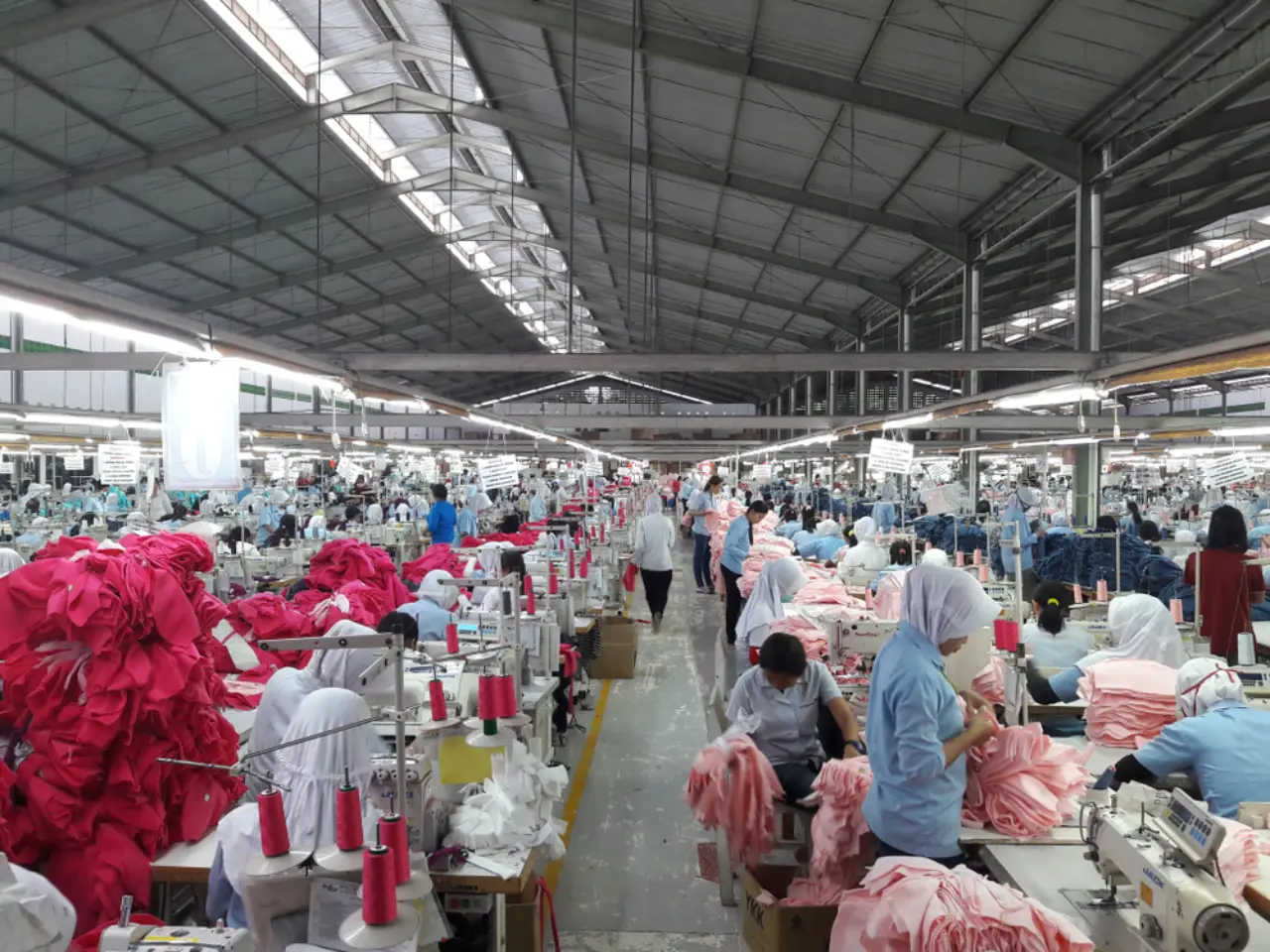Starting and running a clothing manufacturing business can be an exciting venture, especially if you’re passionate about fashion and design. But what is clothing manufacturing exactly? At its core, it involves the creation of garments from scratch, turning raw fabrics into finished products ready for the market. Understanding how it works is crucial for success, from sourcing materials to managing production processes.
For those looking to enter this dynamic industry, partnering with reliable clothing manufacturers is essential. We will walk you through the essential steps and considerations for launching and managing a successful manufacturing business, ensuring you’re well-equipped to make informed decisions and achieve your business goals.
What is Clothing Manufacturing?
It is the intricate process of producing garments, from the initial design to the final product. It encompasses various stages, including sourcing materials, pattern making, cutting, sewing, and finishing. Essentially, what is clothing manufacturing boils down to transforming raw fabrics into wearable items through a series of meticulous steps.
Understanding how clothing manufacturing works is vital for anyone looking to dive into this industry. Clothing manufacturers may also handle quality control, packaging, and distribution. They work closely with designers, fabric suppliers, and other industry professionals to ensure that each garment meets the desired standards of style, fit, and durability. This industry plays a crucial role in bringing fashion trends to life and making clothing accessible to consumers worldwide.
First, Let's Know How Clothing Manufacturing Works
Understanding how clothing manufacturing works is essential for anyone interested in this dynamic industry. Here is a step-by-step guide to it:
- Concept and Design: The process begins with designers creating concepts and sketches. This phase defines the garment’s style, fit, and function.
- Sourcing Materials: Clothing manufacturers source various fabrics and materials based on the design requirements.
- Pattern Making and Sampling: Patterns are created based on the designs, and sample garments are produced. This step is critical as it ensures that the final product matches the design specifications.
- Production Planning: Production planning involves determining the quantities needed and scheduling the manufacturing process.
- Manufacturing Process: The actual clothing manufacturing process includes cutting fabric, sewing garments, and assembling the pieces.
- Quality Control: Quality control checks are implemented throughout the production to ensure that the garments meet the desired standards.
- Packaging and Distribution: Finished garments are packaged and prepared for distribution. Clothing exporter play a significant role in this stage if the products are being sent to international markets.
- Marketing and Sales: Finally, the finished products are marketed and sold. This phase involves positioning the garments in the market to attract the target audience.
Each of these steps plays a crucial role in ensuring the efficiency and quality of the manufacturing process, from concept to final product.
If you want to explore more about different types of clothing manufacturers and find the right fit for your business needs, click on the link to delve deeper.
Here is a Step-By-Step Guide on How One Can Start A Clothing Manufacturing Business
Starting a clothing manufacturing business can be a rewarding venture for those with a passion for fashion and a keen eye for detail. As the fashion industry continues to grow, the demand for unique and high-quality garments is ever-present. Whether you aim to create a niche brand or cater to a broader market, setting up a clothing manufacturing business involves careful planning and execution. This step-by-step guide will walk you through the essential phases of launching your own clothing manufacturing enterprise, from initial concept to production.
Research and Planning
Research and planning form the cornerstone of a successful clothing manufacturing business. Begin by conducting extensive market research to identify current fashion trends, understand consumer preferences, and analyze your competition. This information will help you identify gaps in the market and opportunities for your brand. Next, develop a detailed business plan outlining your business vision, target audience, competitive advantage, pricing strategy, and financial forecasts.
Define Your Niche and Business Model
Your niche refers to the specific segment of the market you want to target, such as eco-friendly fashion, luxury apparel, or activewear. Identifying your niche helps differentiate your brand from competitors and tailor your products to meet the unique needs and preferences of your target audience. Alongside this, your business model outlines how your business will operate and generate revenue. This includes decisions about whether you will produce garments in-house or outsource production, your pricing strategy, distribution channels, and marketing approach.
Legal Requirements
Navigating legal requirements is essential for establishing a legitimate manufacturing business. Start by selecting an appropriate business structure, such as a sole proprietorship, partnership, or limited liability company (LLC), and complete the necessary registration processes. This will determine your liability, tax obligations, and legal responsibilities. Additionally, secure all required permits and licenses specific to your industry and location. Consulting with a legal advisor can help ensure compliance with local regulations and protect your business from potential legal issues.
Design and Development
The design and development phase is where your clothing line takes shape. Begin by creating unique and compelling designs that reflect your brand’s identity and cater to your target market. Develop detailed sketches and technical specifications for each garment. Consider working with professional designers if needed to refine your ideas and create high-quality prototypes. These prototypes are essential for testing the fit, fabric, and overall appeal of your designs before moving to full-scale production.
Sourcing Materials
Sourcing quality materials is crucial for producing garments that meet your standards and satisfy customer expectations. Identify and establish relationships with reliable fabric suppliers who can provide the types of materials needed for your designs. Evaluate the quality, cost, and delivery times of various suppliers to ensure they align with your production needs. In addition to fabrics, source trims, accessories, and other components that will enhance your garments. Consistent material quality is vital for maintaining your brand’s reputation and ensuring customer satisfaction.
Setting Up Production
Setting up your production process involves choosing the right location and investing in the necessary equipment. Decide whether to establish an in-house manufacturing facility or partner with an external clothing exporter. If setting up your own facility, acquire the essential machinery and technology, such as sewing machines, cutting tables, and pattern-making tools. Ensure your production space meets safety and operational standards. An efficient production setup helps streamline your manufacturing process and contributes to consistent product quality and timely delivery.
Production Process
The production process is where your designs come to life. Begin with pattern making and fabric cutting, followed by the sewing and assembly of garments. Implement a systematic approach to ensure that each step, from stitching to finishing touches, is carried out with precision. Quality control is a critical component of this phase, as it involves inspecting each garment for defects and ensuring it meets your quality standards. A well-managed production process ensures that your products are both high-quality and produced in a timely manner.
Marketing and Sales
Effective marketing and sales strategies are essential for building brand recognition and driving sales. Develop a strong brand identity, including a memorable logo, compelling brand story, and consistent visual elements. Create a marketing plan that includes online and offline tactics, such as social media campaigns, influencer partnerships, and trade show appearances. Establish sales channels, such as an e-commerce site or retail partnerships, to reach your target audience.
Distribution and Logistics
Efficient distribution and logistics are vital for delivering your products to customers and retailers smoothly. Develop a packaging strategy that protects your garments during transit while enhancing brand presentation. Set up a distribution network that ensures timely and accurate delivery of products. This includes coordinating with shipping companies, managing inventory, and handling order fulfillment. Effective logistics management helps maintain customer satisfaction and ensures that your products reach the market efficiently.
Financial Management
Sound financial management is crucial for the sustainability and growth of your clothing manufacturing business. Implement a robust accounting system to track expenses, revenues, and profit margins. Create a budget that reflects your operational costs, production expenses, and marketing investments. Explore funding options, such as loans or investor contributions, if needed to support business expansion. Effective financial management helps you maintain profitability, manage cash flow, and make informed decisions for your business’s future.
Build a Skilled Team
Building a skilled team is pivotal to the success of a clothing manufacturing business. Assemble a group of professionals who bring a diverse set of skills and expertise to the table, including designers, pattern makers, fabric specialists, and production managers. Each team member should be well-versed in their specific area, from fashion design and textile science to manufacturing processes and quality control. Investing in talent not only enhances the creativity and efficiency of your operations but also drives innovation and maintains high standards across all facets of production.
Each step is integral to building a successful manufacturing business, ensuring that you are well-prepared to navigate the complexities of the fashion industry and achieve long-term success. By following these steps, you can effectively navigate the complexities of starting and running a successful clothing manufacturing business.
Conclusion
Starting and running a clothing manufacturing business involves a multifaceted approach that combines creativity, strategic planning, and operational efficiency. From conducting thorough market research and developing a solid business plan to navigating legal requirements and setting up production, each step plays a crucial role in establishing a successful venture. Defining your niche, sourcing quality materials, and building a skilled team further contribute to the strength and resilience of your business. Effective marketing and distribution strategies and sound financial management are essential for growth and sustainability. By carefully executing these steps and remaining adaptable to industry changes, you can build a thriving business that stands out in the competitive fashion landscape.
With the right strategies and partners, you can successfully navigate the complexities of the clothing manufacturing industry and achieve your business goals.
Popular Search:
Clothing Manufacturers Designer Shirt Manufacturers Men’s Designer Shirt Manufacturer in India Men’s Shirt Manufacturers Shirt Manufacturers in India Private Label Clothing Manufacturers Private Label Clothing Manufacturers in India School Uniform Manufacturers Uniform Manufacturer in India White Label Clothing White Label Clothing Manufacturer in India

